Transactional Email vs Marketing Email – What’s the Difference + Explanation + Examples
Transactional emails and marketing emails – you have probably heard these terms before. However, the definitions are not always very clear, which might leave you unsure about the differences and why you should take the time to differentiate them. In this article, I’ll simplify these terms as much as possible, help you cover the basics of transactional vs. marketing emails, show you some examples of each, and answer frequently asked questions.
What is a transactional email?
Transactional emails are emails that are sent as a direct response to a user’s actions in an application, service, or website. Single sign-on, password reset, welcome email, order confirmation, receipt – these all are examples of transactional emails.
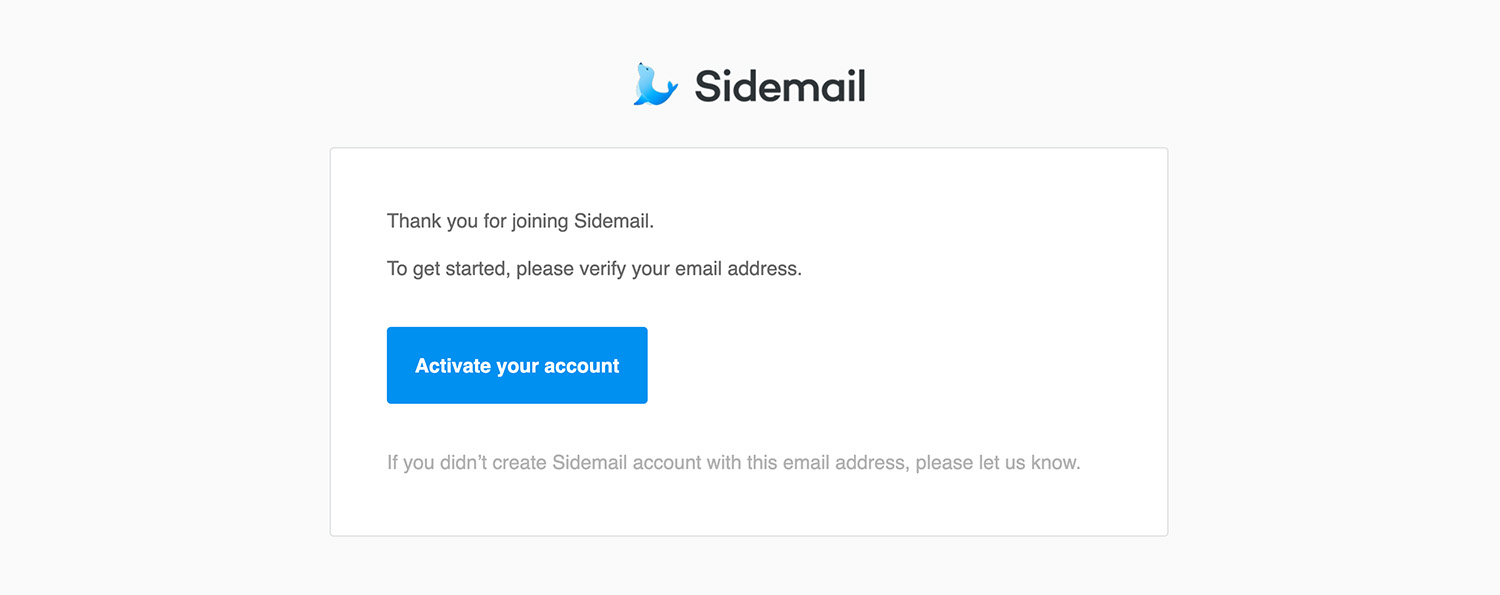
What is a marketing email?
Marketing emails (also known as promotional emails, commercial emails, newsletters, broadcast emails, or bulk emails) are emails that a company member, usually a marketing person, sends to a large group of contacts who have agreed to receive promotional messages from the company. Examples of marketing emails include product updates, weekly/monthly newsletters, announcements, and sale or promo offers.
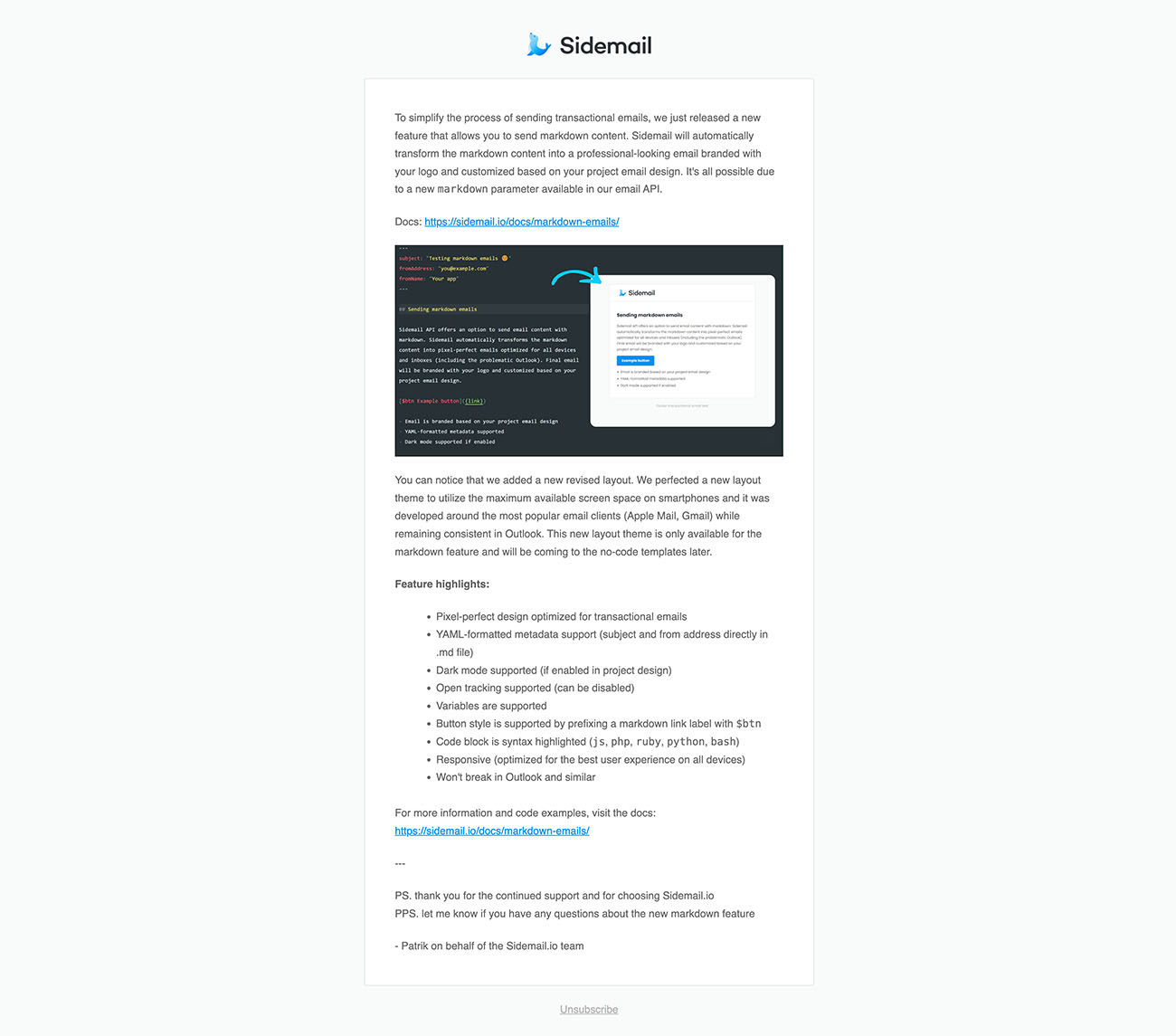
What is the difference between transactional email vs marketing email?
Now that we know the definitions of transactional and marketing emails, let’s go through their differences.
| Transactional email | Marketing email |
| Triggered by a user’s action | Sent (manually) by a company employee |
| Sent to 1 user | Sent to a group of users |
| – | Requires user’s explicit opt-in |
| Content customized to specific user | General content |
| Main purpose is to inform / direct communication with the user | Main purpose is promotion of the company |
| Unsubscribe link is not needed | Must include unsubscribe link |
| Delivery speed is crutial factor | Delivery time usually optimized for recipient’s convenience, possible timezone optimization |
| – | Regulated by GDPR, CAN-SPAM, and similar regulations |
| Part of critical architecture of the application | – |
| Higher user engagement and open rates | Usually lower open rates |
The main differences between transactional emails and marketing emails are:
- Trigger ⚡ – Transactional emails are triggered by a specific user action in your application, service, website, or similar. Marketing emails are sent to a group of contacts, usually by a marketing employee of the company.
- Opt-in 🤝 – Marketing emails, in contrast to transactional emails, require explicit opt-in by a recipient. Marketing emails are also regulated by GDPR, CAN-SPAM, and other regulations.
- Email content 💌 – The content of a transactional email is customized to the specific user and usually contains unique information, links, or data for the user. It’s direct one-on-one communication. On the other hand, the content of a marketing email is rather general and promotional, often as part of a marketing campaign.
- Unsubscribe link 📫 – All marketing emails must contain an unsubscribe link, giving the recipient the right to opt-out from receiving further promotional emails from the company at any time. Transactional emails do not need unsubscribe links.
- Delivery speed and time ⌛ – Transactional emails are part of the critical architecture of an application, service, or website. Therefore, deliverability rates and speed are crucial. A good transactional email provider should deliver emails reliably and within a few milliseconds. For marketing emails, the delivery speed is generally less critical. Marketing emails are rather optimized to reach the recipient at the most convenient time, often using timezone-based delivery for optimization.
- Engagement and open rates 📈 – Transactional emails generally have higher engagement and open rates than marketing emails. On average, transactional emails tend to have an open rate between 40% and 60% due to their nature of being triggered by user actions and containing important information that the recipient is expecting or needs to access. In contrast, marketing emails usually have an open rate ranging from 20% to 30%, though this can vary widely based on factors such as industry, target audience, email content, and the quality of the email list.
Why do I need to differentiate between transactional and marketing emails?
As introduced in the previous section, transactional emails and marketing emails have different specifics, are sent with different purposes, and need to comply with different regulations. Therefore, companies must have knowledge regarding the specifics of transactional and marketing emails to comply with email regulations and ensure the best possible experience for their users.
By separating transactional and marketing emails, you can achieve better deliverability results. For transactional emails, deliverability speed is crucial, so they should always have the highest priority for email sending. However, marketing emails also need to be reliably delivered.
Also, when you separate transactional and marketing emails, email service providers can better identify and categorize your emails in users’ inboxes.
Additionally, separating transactional and marketing emails simplifies troubleshooting and potential debugging, while also saving time for your support team.
And how to separate transactional and marketing email sending?
Generally, the best practice is to separate your emails by using different "from" names, "from" addresses, and IP addresses. Today, there are email sending providers that can help you easily manage this. For example, Sidemail manages all the separation, unsubscribe link handling, and email delivery for you, and provides you with industry best practises. You can check out Sidemail and start a free trial here.
Do transactional emails need to contain an unsubscribe link?
No, transactional emails do not need to contain an unsubscribe link. As explained earlier, transactional emails are sent in response to a user’s action in your application, service, or website. Therefore, if you're sending transactional emails such as password resets, single sign-on confirmations, receipts, or similar messages, they do not need to include an unsubscribe link.
Do marketing emails need to contain an unsubscribe link?
Yes, all marketing emails must contain an unsubscribe link. Therefore, if you're sending newsletters, product updates, discount offers, or similar promotional emails, you are required to include an unsubscribe link. Also, it's important to keep in mind that to send marketing emails to a recipient, you need to have their explicit opt-in to receive such marketing messages from your company.
Transactional email examples
Now that we understand the definition and specifics of transactional emails, let's explore some examples.
Password reset email
Perhaps the most recognized transactional email, the password reset email is sent to a user after they request to change their password. This email verifies the user's action and allows them to proceed with updating their password securely.
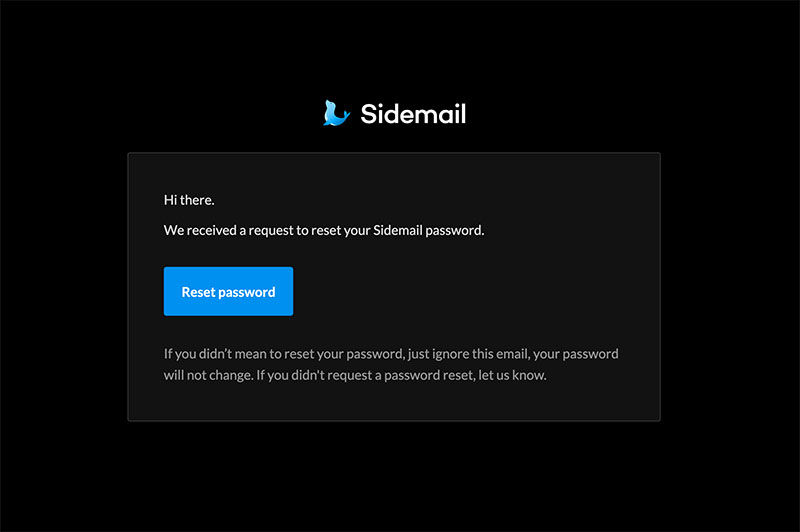
Single-sign-on email (SSO)
For applications or services offering passwordless login, the single sign-on email facilitates user login. Users enter their email, request an SSO email, and receive a login link via your transactional email provider. Clicking the link logs them into your application or service.
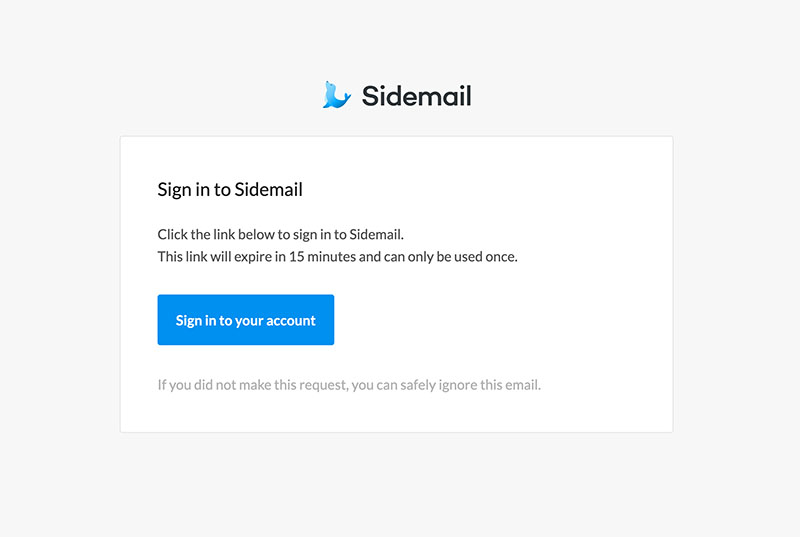
Receipt, Order confirmation, Subscription activation emails
After a successful payment, it’s good practice to send your user an email with a receipt, order confirmation, or subscription activation. You can also use these emails to thank users, build trust, and foster good relationships.

Registration & Welcome email
Registration and welcome emails are crucial for making a good first impression. They can help you establish a great relationship with users, guide them through their first steps in your application or service, or offer assistance if they need it.
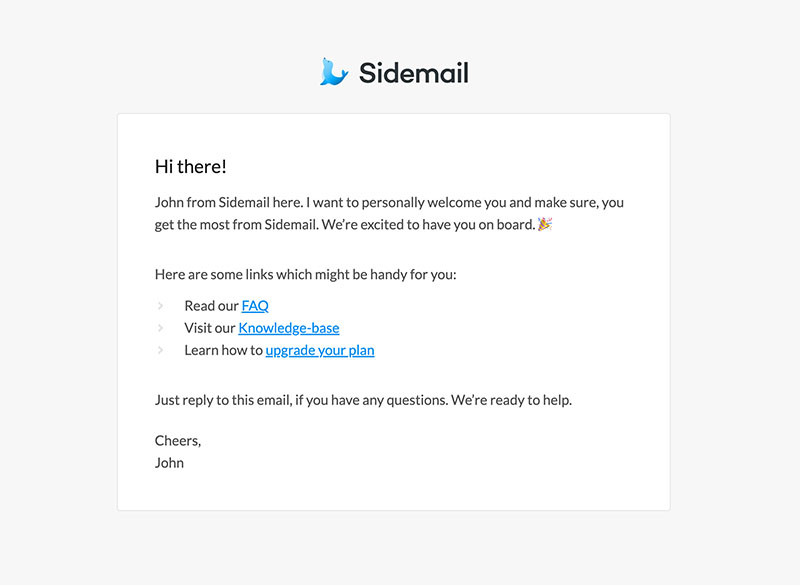
Account activation email & Email address verification
If you have a SaaS platform, you'll probably want to verify your users' email addresses before they get started. To do this, you can use an email API to send an activation email. Users verify their email address by clicking the link inside this email.
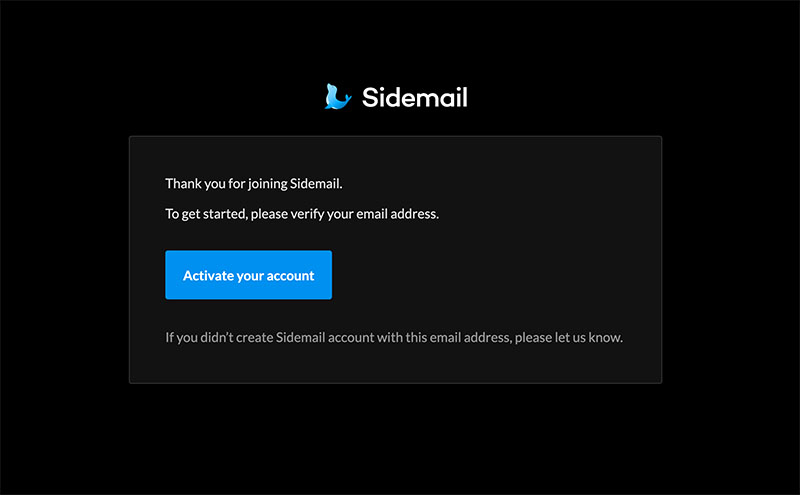
Dunning emails
Dunning emails notify users about issues with payments. These emails are typical for SaaS and play an important role in churn prevention, building trust, and managing subscriptions. Examples of dunning emails include:
- Payment attempt failed
- Subscription renewal issue
- Expired credit card information
- Authorization issues
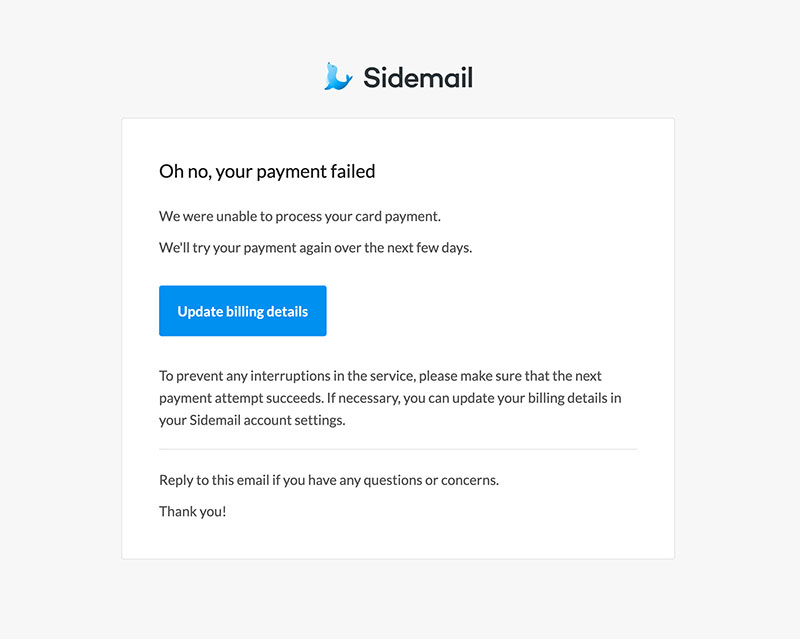
Marketing email examples
And now, let’s look at some examples of marketing emails.
Newsletters & Product updates
Have you introduced a new feature, improved your application, or recorded a new tutorial video? These are amazing opportunities to reach out to your users and audience, sharing what you’re up to. You can also use newsletters to ask for their thoughts and collect feedback.
Discounts & special offers
Companies often offer special discounts for celebrations and holidays like Black Friday, New Year, and Summer holidays. Email marketing is a great way to spread the word about your offers. You can also combine it with discount codes, buy-more-save-more offers, and other strategies depending on your resources and creativity.

Need to help with transactional and marketing emails?
Do you need help with your transactional and marketing emails? We’re here for you! We’re experts on email delivery and enjoy working with clients directly. Whether you need help separating transactional and marketing emails, managing and delivering emails for your service, integrating transactional emails into your application, or anything else related to emails, we've got you covered. You can reach out to me directly at [email protected] or check Sidemail, our email platform.
👉 Try Sidemail today
Navigating between the specifics of transactional and marketing emails is not easy. We will help you to simplify it as much as possible. Create your account now and start sending your emails in under 30 minutes.